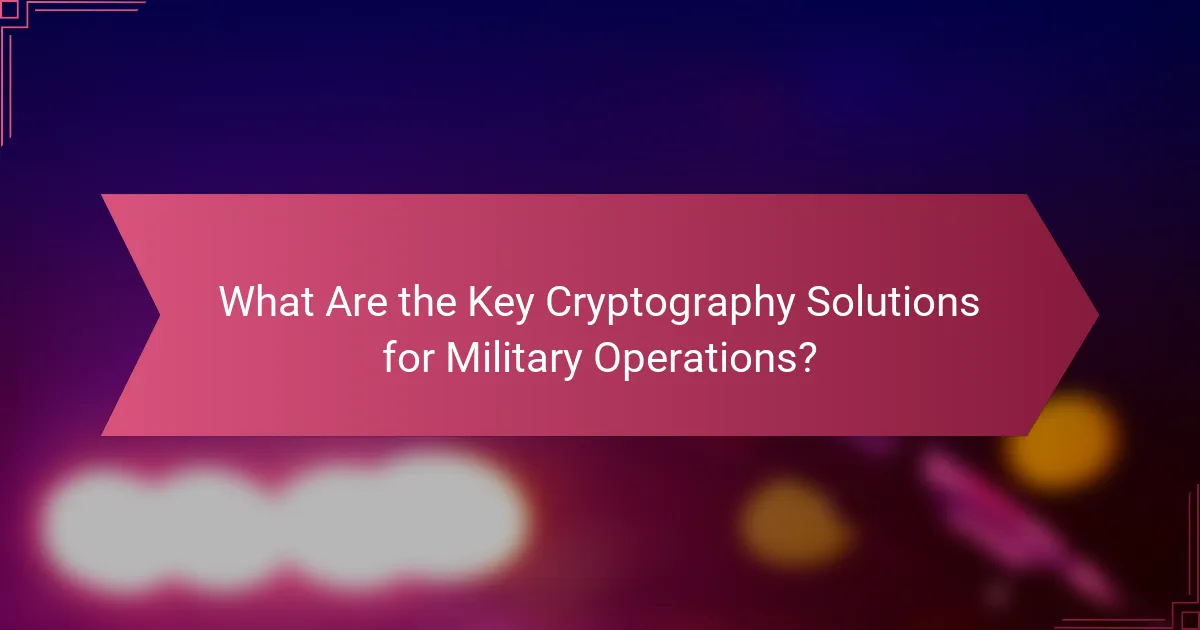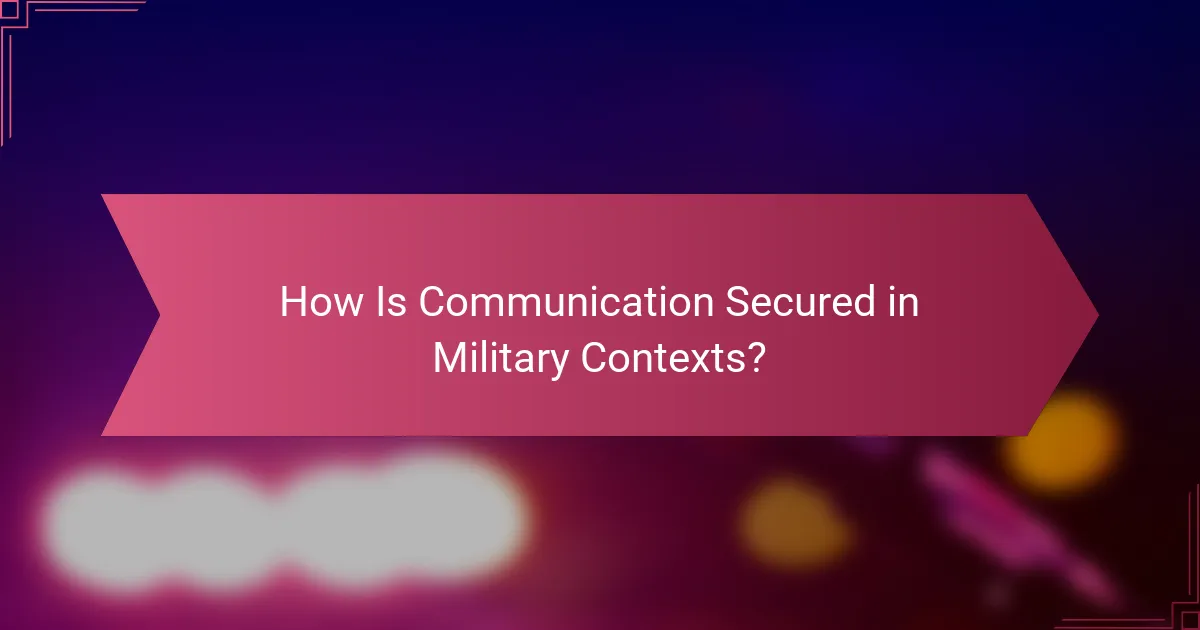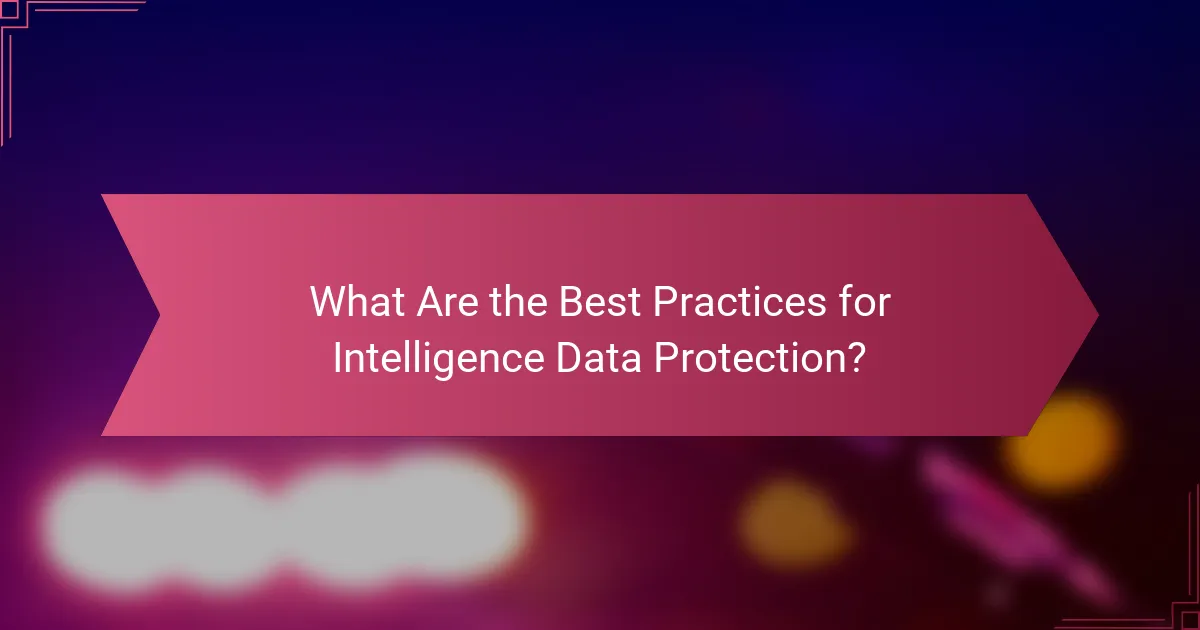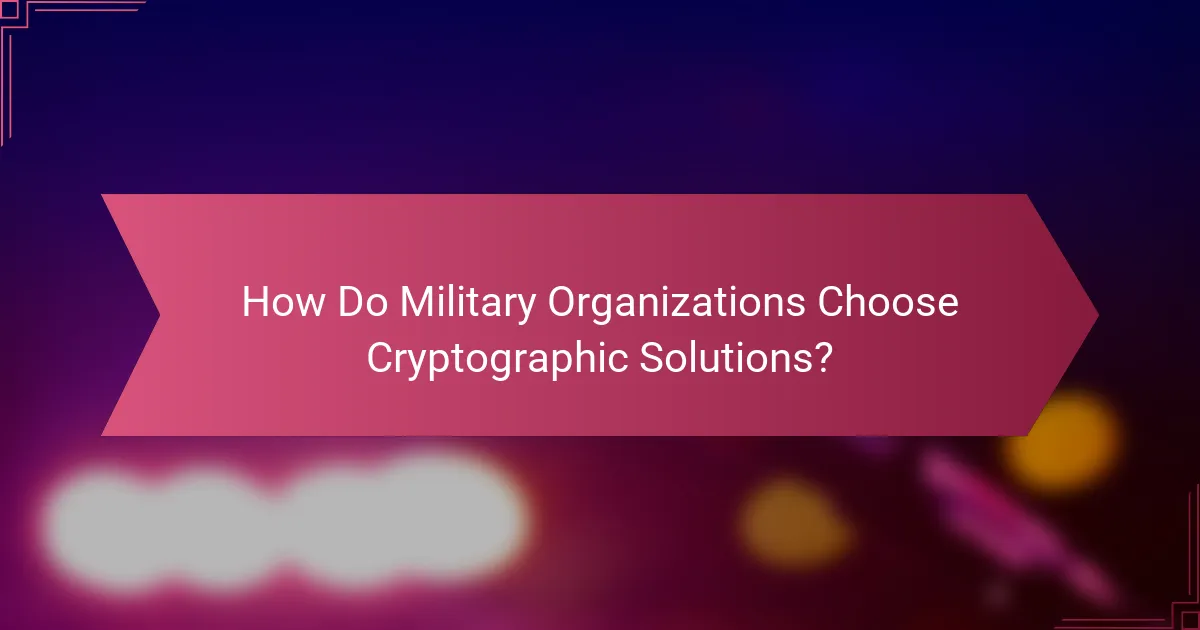Cryptography plays a vital role in military operations by securing communications and safeguarding sensitive information from adversaries. Advanced techniques ensure the confidentiality, integrity, and authenticity of data, which are essential in defense scenarios. By employing secure voice systems, encrypted messaging, and strict protocols, military communication is fortified against interception and unauthorized access.

What Are the Key Cryptography Solutions for Military Operations?
Key cryptography solutions for military operations include various advanced techniques designed to secure communications and protect sensitive information. These solutions ensure confidentiality, integrity, and authenticity, which are crucial in defense scenarios.
Advanced Encryption Standard (AES)
The Advanced Encryption Standard (AES) is a symmetric encryption algorithm widely used in military applications for securing classified information. It operates on fixed block sizes of 128 bits and supports key lengths of 128, 192, or 256 bits, providing robust security against unauthorized access.
AES is favored for its efficiency and speed, making it suitable for real-time communications. Military organizations often implement AES in secure communication devices, ensuring that data remains confidential during transmission.
Elliptic Curve Cryptography (ECC)
Elliptic Curve Cryptography (ECC) is a public-key encryption technique that offers high security with smaller key sizes compared to traditional methods like RSA. This efficiency is particularly beneficial for military operations where computational power and bandwidth may be limited.
ECC provides strong encryption for secure communications and is increasingly used in military applications, such as secure messaging and data transmission. Its ability to maintain security with shorter keys makes it ideal for mobile and embedded systems.
Quantum Key Distribution (QKD)
Quantum Key Distribution (QKD) leverages the principles of quantum mechanics to create secure communication channels. It enables two parties to generate a shared, secret key that is theoretically immune to eavesdropping, as any attempt to intercept the key alters the quantum state and alerts the parties involved.
Although still in the experimental stage, QKD holds great promise for military operations where maximum security is paramount. Its implementation requires specialized equipment and infrastructure, making it a more complex solution compared to traditional cryptographic methods.
Secure Multiparty Computation (SMPC)
Secure Multiparty Computation (SMPC) allows multiple parties to jointly compute a function over their inputs while keeping those inputs private. This is particularly useful in military scenarios where collaboration is necessary, but data confidentiality must be preserved.
SMPC can be applied in various contexts, such as joint intelligence analysis or collaborative decision-making. However, it often requires significant computational resources and careful design to ensure efficiency and security.
Homomorphic Encryption
Homomorphic Encryption enables computations to be performed on encrypted data without needing to decrypt it first. This allows military organizations to process sensitive information securely while maintaining confidentiality.
While promising, homomorphic encryption is computationally intensive and can be slower than traditional methods. Its application in military operations is still developing, but it offers a unique solution for secure data analysis and processing in sensitive environments.

How Is Communication Secured in Military Contexts?
Communication in military contexts is secured through a combination of advanced technologies and strict protocols designed to protect sensitive information from interception and unauthorized access. This includes the use of secure voice systems, encrypted messaging, VPNs, and satellite communications.
Use of Secure Voice Communication Systems
Secure voice communication systems are essential for military operations, allowing personnel to communicate without the risk of eavesdropping. These systems often utilize encryption to convert voice data into a format that is unreadable to unauthorized listeners.
Examples include devices that comply with military standards such as STANAG 4609, which ensures interoperability and security across different branches of the armed forces. Regular updates and maintenance are crucial to address potential vulnerabilities.
Implementation of Encrypted Messaging Apps
Encrypted messaging apps provide a secure platform for military personnel to exchange messages without the risk of interception. These applications use end-to-end encryption, ensuring that only the sender and recipient can read the messages.
Popular options may include military-grade applications that meet specific security requirements, such as the use of AES-256 encryption. Users should be trained on best practices to avoid common pitfalls, such as sharing devices or using unsecured networks.
Deployment of Virtual Private Networks (VPNs)
VPNs are deployed to create secure connections over the internet, allowing military personnel to access sensitive information remotely without exposing it to potential threats. A VPN encrypts data traffic, making it difficult for adversaries to intercept communications.
When selecting a VPN, it is important to choose one that offers strong encryption protocols and has a proven track record of reliability. Military operations often require the use of dedicated VPNs that comply with specific security standards.
Utilization of Secure Satellite Communications
Secure satellite communications are vital for military operations, particularly in remote areas where traditional communication infrastructure may be lacking. These systems provide reliable, encrypted communication channels that can withstand interference and jamming attempts.
Military satellite systems often employ advanced encryption techniques to protect data transmitted over long distances. Personnel must be trained to operate these systems effectively, ensuring that they can maintain communication even in challenging environments.

What Are the Best Practices for Intelligence Data Protection?
Best practices for intelligence data protection involve implementing robust security measures to safeguard sensitive information from unauthorized access and breaches. This includes establishing clear protocols for data classification, access control, regular audits, employee training, and incident response planning.
Data Classification and Access Control
Data classification is essential for identifying the sensitivity of information and determining who should have access to it. Implement a tiered classification system, such as public, internal, confidential, and top secret, to ensure that only authorized personnel can access sensitive data.
Access control mechanisms, such as role-based access control (RBAC), help enforce these classifications. Regularly review and update access permissions to adapt to changes in personnel or organizational structure, minimizing the risk of unauthorized access.
Regular Security Audits and Assessments
Conducting regular security audits and assessments is crucial for identifying vulnerabilities in your data protection strategies. Schedule these audits at least annually, or more frequently if significant changes occur within your organization or technology stack.
Utilize both internal and external auditors to gain a comprehensive view of your security posture. Implement findings promptly to address weaknesses and enhance your overall data protection framework.
Employee Training on Cybersecurity Protocols
Training employees on cybersecurity protocols is vital for maintaining data security. Regular training sessions should cover topics such as phishing awareness, password management, and secure data handling practices.
Consider using simulated phishing attacks to reinforce training and assess employee readiness. Establish a culture of security awareness, encouraging employees to report suspicious activities without fear of repercussions.
Incident Response Planning
Having a well-defined incident response plan is critical for minimizing the impact of data breaches. This plan should outline roles and responsibilities, communication strategies, and steps for containment and recovery.
Regularly test and update the incident response plan to ensure its effectiveness. Conduct tabletop exercises to simulate potential incidents, allowing your team to practice their response and identify areas for improvement.

What Are the Challenges in Military Cryptography?
Military cryptography faces significant challenges that include adapting to rapidly changing cyber threats, balancing security with operational efficiency, and integrating legacy systems with modern cryptographic solutions. These factors are crucial for maintaining secure communications and effective intelligence operations.
Adapting to Evolving Cyber Threats
Adapting to evolving cyber threats is essential for military cryptography. Cyber adversaries continuously develop new techniques to breach security, requiring military organizations to update their cryptographic methods regularly. This includes implementing advanced encryption algorithms and employing real-time threat intelligence to stay ahead of potential attacks.
Military units must also conduct regular training and simulations to prepare personnel for emerging threats. This proactive approach helps ensure that cryptographic systems remain resilient against sophisticated cyber intrusions.
Balancing Security and Operational Efficiency
Balancing security and operational efficiency is a critical challenge in military cryptography. While robust encryption is necessary to protect sensitive information, overly complex systems can hinder communication speed and effectiveness during operations. Military leaders must find a middle ground that allows for secure communications without compromising mission success.
One strategy is to implement tiered security levels, where different types of information are encrypted with varying degrees of complexity based on their sensitivity. This approach can streamline operations while still safeguarding critical data.
Integration of Legacy Systems with Modern Solutions
Integrating legacy systems with modern cryptographic solutions poses a significant obstacle for military organizations. Many military systems were designed years ago and may not support current encryption standards or protocols. This can create vulnerabilities and complicate communication between different units.
To address this, military organizations should prioritize phased upgrades of legacy systems, ensuring compatibility with contemporary technologies. Collaboration with technology providers can also facilitate smoother transitions and enhance overall security posture.

How Do Military Organizations Choose Cryptographic Solutions?
Military organizations select cryptographic solutions based on security needs, operational requirements, and the specific threats they face. Factors such as encryption strength, speed, and interoperability with existing systems play crucial roles in this decision-making process.
Assessing Security Requirements
When evaluating cryptographic solutions, military organizations begin by assessing their security requirements. This involves identifying the types of data that need protection, the potential threats, and the consequences of data breaches. For instance, classified communications may require stronger encryption than routine operational messages.
Organizations often categorize data into different levels of sensitivity, which helps determine the appropriate cryptographic measures. The use of standards such as the National Institute of Standards and Technology (NIST) guidelines can aid in this assessment.
Evaluating Performance and Usability
Performance and usability are critical when choosing cryptographic solutions for military operations. Solutions must provide strong encryption without significantly slowing down communication processes. For example, real-time data transmission may necessitate faster algorithms that still meet security standards.
Usability is equally important; personnel must be able to implement and use the cryptographic tools effectively. Complex systems may lead to errors or misuse, which can compromise security. Training and user-friendly interfaces can mitigate these risks.
Interoperability with Existing Systems
Interoperability is a key consideration for military organizations when selecting cryptographic solutions. New systems must work seamlessly with existing technologies to ensure secure communication across various platforms. This is particularly important in joint operations where multiple branches or allied forces are involved.
Organizations often conduct compatibility tests and pilot programs to evaluate how well new solutions integrate with current systems. This helps avoid disruptions in communication and ensures that all parties can securely exchange information.
Cost and Resource Considerations
Cost is a significant factor in the decision-making process for military cryptographic solutions. Organizations must balance the need for robust security with budget constraints. Solutions that offer high security at a reasonable cost are preferred, but the cheapest option is not always the best.
Additionally, resource availability, including personnel training and maintenance, should be factored into the overall cost. Investing in high-quality cryptographic solutions can lead to long-term savings by preventing costly security breaches.
